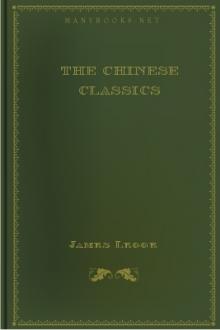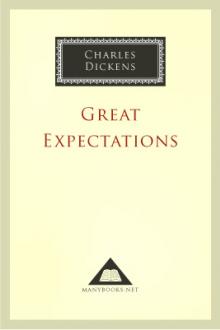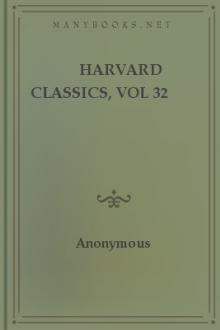The Chinese Classics (Prolegomena) by James Legge (e novels to read .txt) 📕

- Author: James Legge
- Performer: -
Book online «The Chinese Classics (Prolegomena) by James Legge (e novels to read .txt) 📕». Author James Legge
These views are based on a misinterpretation of the entry in the
1 �z�t�l���l.
2 See the �|�����l��, art. ���e.
3 �C�v�j��,�����O�����e�@�g,���D�����g,������y.
4 �����n��,���e�j���G�g,���~������,���b���O����,�@�g���w,���l�����y,�] ���@�g��,�����T�Q�T��,���j�������g�����i���o.
Catalogue. It does not speak of two p’ien of the Chung Yung, but of two p’ien of Observations thereon. The Great Learning carries on its front the evidence of being incomplete, but the student will not easily believe that the Doctrine of the Mean is so. I see no reason for calling its integrity in question, and no necessity therefore to recur to the ingenious device employed in the edition of the five ching published by the imperial authority of K’ang Hsi, to get over the difficulty which Wang Wei supposes. It there appears in two p’ien, of which we have the following account from the author of ‘Supplemental Remarks upon the Four Books:’— ‘The proper course now is to consider the first twenty chapters in Chu Hsi’s arrangement as making up the first p’ien, and the remaining thirteen as forming the second. In this way we retain the old form of the Treatise, and do not come into collision with the views of Chu. For this suggestion we are indebted to Lu Wang-chai’ (an author of the Sung dynasty ) [1].
SECTION IV.
ITS SCOPE AND VALUE.
1. The Doctrine of the Mean is a work not easy to understand. ‘It first,’ says the philosopher Chang, ‘speaks of one principle; it next spreads this out and embraces all things; finally, it returns and gathers them up under the one principle. Unroll it and it fills the universe; roll it up, and it retires and lies hid in secrecy [2].’ There is this advantage, however, to the student of it, that more than most other Chinese Treatises it has a beginning, a middle, and an end. The first chapter stands to all that follows in the character of a text, containing several propositions of which we have the expansion or development. If that development were satisfactory, we should be able to bring our own minds en rapport with that of the author. Unfortunately it is not so. As a writer he belongs to the intuitional school more than to the logical. This is well put in the ‘Continuation of the General Examination of Literary Monuments and Learned Men,’— ‘The philosopher Tsang reached his conclusions by following in the train of things, watch-1 See the �|�����l��, art. ���e.
2 See the Introductory note of Chu Hsi.
ing and examining; whereas Tsze-sze proceeds directly and reaches to Heavenly virtue. His was a mysterious power of discernment, approaching to that of Yen Hui [1].’ We must take the Book and the author, however, as we have them, and get to their meaning, if we can, by assiduous examination and reflection.
2. ‘Man has received his nature from Heaven. Conduct in accordance with that nature constitutes what is right and true,— is a pursuing of the proper Path. The cultivation or regulation of that path is what is called Instruction.’ It is with these axioms that the Treatise commences, and from such an introduction we might expect that the writer would go on to unfold the various principles of duty, derived from an analysis of man’s moral constitution.
Confining himself, however, to the second axiom, he proceeds to say that ‘the path may not for an instant be left, and that the superior man is cautious and careful in reference to what he does not see, and fearful and apprehensive in reference to what he does not hear. There is nothing more visible than what is secret, and nothing more manifest than what is minute, and therefore the superior man is watchful over his aloneness.’ This is not all very plain. Comparing it with the sixth chapter of Commentary in the Great Learning, it seems to inculcate what is there called ‘making the thoughts sincere.’ The passage contains an admonition about equivalent to that of Solomon,— ‘Keep thy heart with all diligence, for out of it are the issues of life.’
The next paragraph seems to speak of the nature and the path under other names. ‘While there are no movements of pleasure, anger, sorrow, or joy, we have what may be called the state of equilibrium. When those feelings have been moved, and they all act in the due degree, we have what may be called the state of harmony. This equilibrium is the great root of the world, and this harmony is its universal path.’ What is here called ‘the state of equilibrium,’ is the same as the nature given by Heaven, considered absolutely in itself, without deflection or inclination. This nature acted on from without, and responding with the various emotions, so as always ‘to hit [2]’ the mark with entire
1 See the �����m�q��, Bk. cxcix, art. �l��,—���l�o���_�H������,���l�� ����,�h���F���w,�f�X�C��������.
2 ���`.
correctness, produces the state of harmony, and such harmonious response is the path along which all human activities should proceed.
Finally. ‘Let the states of equilibrium and harmony exist in perfection, and a happy order will prevail throughout heaven and earth, and all things will be nourished and flourish.’ Here we pass into the sphere of mystery and mysticism. The language, according to Chu Hsi, ‘describes the meritorious achievements and transforming influence of sage and spiritual men in their highest extent.’ From the path of duty, where we tread on solid ground, the writer suddenly raises us aloft on wings of air, and will carry us we know not where, and to we know not what.
3. The paragraphs thus presented, and which constitute Chu Hsi’s first chapter, contain the sum of the whole Work. This is acknowledged by all;— by the critics who disown Chu Hsi’s interpretations of it, as freely as by him [1]. Revolving them in my own mind often and long, I collect from them the following as the ideas of the author:— Firstly, Man has received from Heaven a moral nature by which he is constituted a law to himself; secondly, Over this nature man requires to exercise a jealous watchfulness; and thirdly, As he possesses it, absolutely and relatively, in perfection, or attains to such possession of it, he becomes invested with the highest dignity and power, and may say to himself— ‘I am a god; yea, I sit in the seat of God.’ I will not say here that there is impiety in the last of these ideas; but do we not have in them the same combination which we found in the Great Learning,— a combination of the ordinary and the extraordinary, the plain and the vague, which is very perplexing to the mind, and renders the Book unfit for the purposes of mental and moral discipline?
And here I may inquire whether we do right in calling the Treatise by any of the names which foreigners have hitherto used for it? In the note on the title, I have entered a little into this question. The Work is not at all what a reader must expect to find in what he supposes to be a treatise on ‘The Golden Medium,’ ‘The Invariable Mean,’ or ‘The Doctrine of the Mean.’ Those
l Compare Chu Hsi’s language in his concluding note to the first chapter:— ���������@�g�����n, and Mao Hsi-ho’s, in his ���e��, ���@, p. 11:— �����e�@�������n�].
names are descriptive only of a portion of it. Where the phrase Chung Yung occurs in the quotations from Confucius, in nearly every chapter from the second to the eleventh, we do well to translate it by ‘the course of the Mean,’ or some similar terms; but the conception of it in Tsze-sze’s mind was of a different kind, as the preceding analysis of the first chapter sufficiently shows [1].
4. I may return to this point of the proper title for the Work again, but in the meantime we must proceed with the analysis of it.— The ten chapters from the second to the eleventh constitute the second part, and in them Tsze-sze quotes the words of Confucius, ‘for the purpose,’ according to Chu Hsi, ‘of illustrating the meaning of the first chapter.’ Yet, as I have just intimated, they do not to my mind do this. Confucius bewails the rarity of the practice of the Mean, and graphically sets forth the difficulty of it. ‘The empire, with its component States and families, may be ruled; dignities and emoluments may be declined; naked weapons may be trampled under foot; but the course of the Mean can not be attained to [2].’ ‘The knowing go beyond it, and the stupid do not come up to it [3].’ Yet some have attained to it. Shun did so, humble and ever learning from people far inferior to himself [4]; and Yen Hui did so, holding fast whatever good he got hold of, and never letting it go [5]. Tsze-lu thought the Mean could be taken by storm, but Confucius taught him better [6]. And in fine, it is only the sage who can fully exemplify the Mean [7].
All these citations do not throw any light on the ideas presented in the first chapter. On the contrary, they interrupt the train of thought. Instead of showing us how virtue, or the path of duty is in accordance with our Heaven-given nature, they lead us to think of it as a mean between two extremes. Each extreme may be a violation of the law of our nature, but that is not made to appear. Confucius’s sayings would be in place in illustrating the doctrine of the Peripatetics, ‘which placed all virtue in a medium between opposite vices [8].’ Here in the Chung Yung of Tsze-sze I have always felt them to be out of place.
5. In the twelfth chapter Tsze-sze speaks again himself, and we seem at once to know the voice. He begins by saying that ‘the way of the superior man reaches far and wide, and yet is
1 In the version in ‘The Sacred Books of the East,’ I call the Treatise ‘The State of Equilibrium and Harmony.’
2 Ch. ix.
3 Ch. iv.
4 Ch. vi.
5 Ch. viii.
6 Ch. x.
7 Ch. xi.
8 Encyclopaedia Britannica, Preliminary Dissertations, p. 318, eighth edition.
secret,’ by which he means to tell us that the path of duty is to be pursued everywhere and at all times, while yet the secret spring and rule of it is near at hand, in the Heaven-conferred nature, the individual consciousness, with which no stranger can intermeddle. Chu Hsi, as will be seen in the notes, gives a different interpretation of the utterance. But the view which I have adopted is maintained convincingly by Mao Hsi-ho in the second part of his ‘Observations on the Chung Yung.’ With this chapter commences the third part of the Work, which embraces also the eight chapters which follow. ‘It is designed,’ says Chu Hsi, ‘to illustrate what is said in the first chapter that “the path may not be left.”’ But more than that one sentence finds its illustration here. Tsze-sze had reference in it also to what he had said— ‘The superior man does not wait till he sees things to be cautious, nor till he hears things to be apprehensive. There is nothing more visible than what is secret, and nothing more manifest than what is minute. Therefore, the superior man is watchful over himself when he is alone.’





Comments (0)